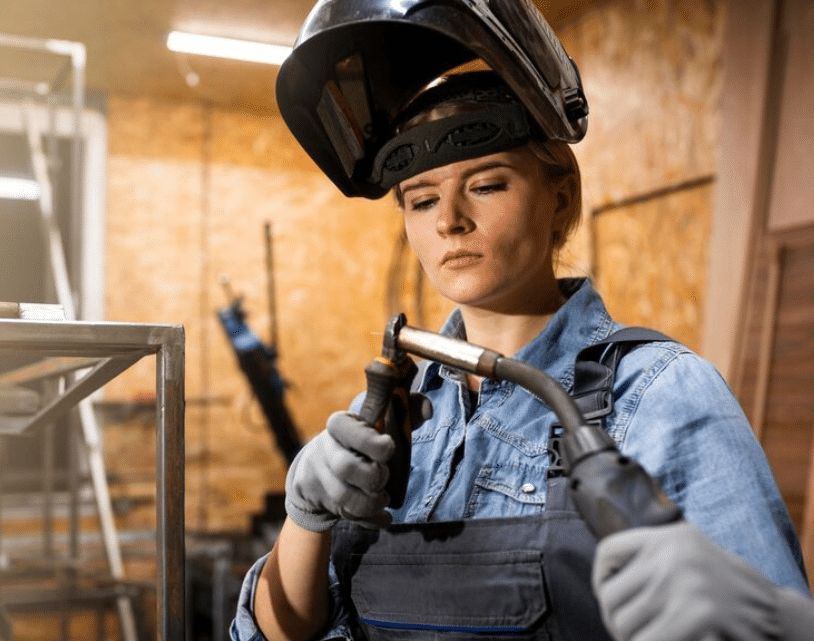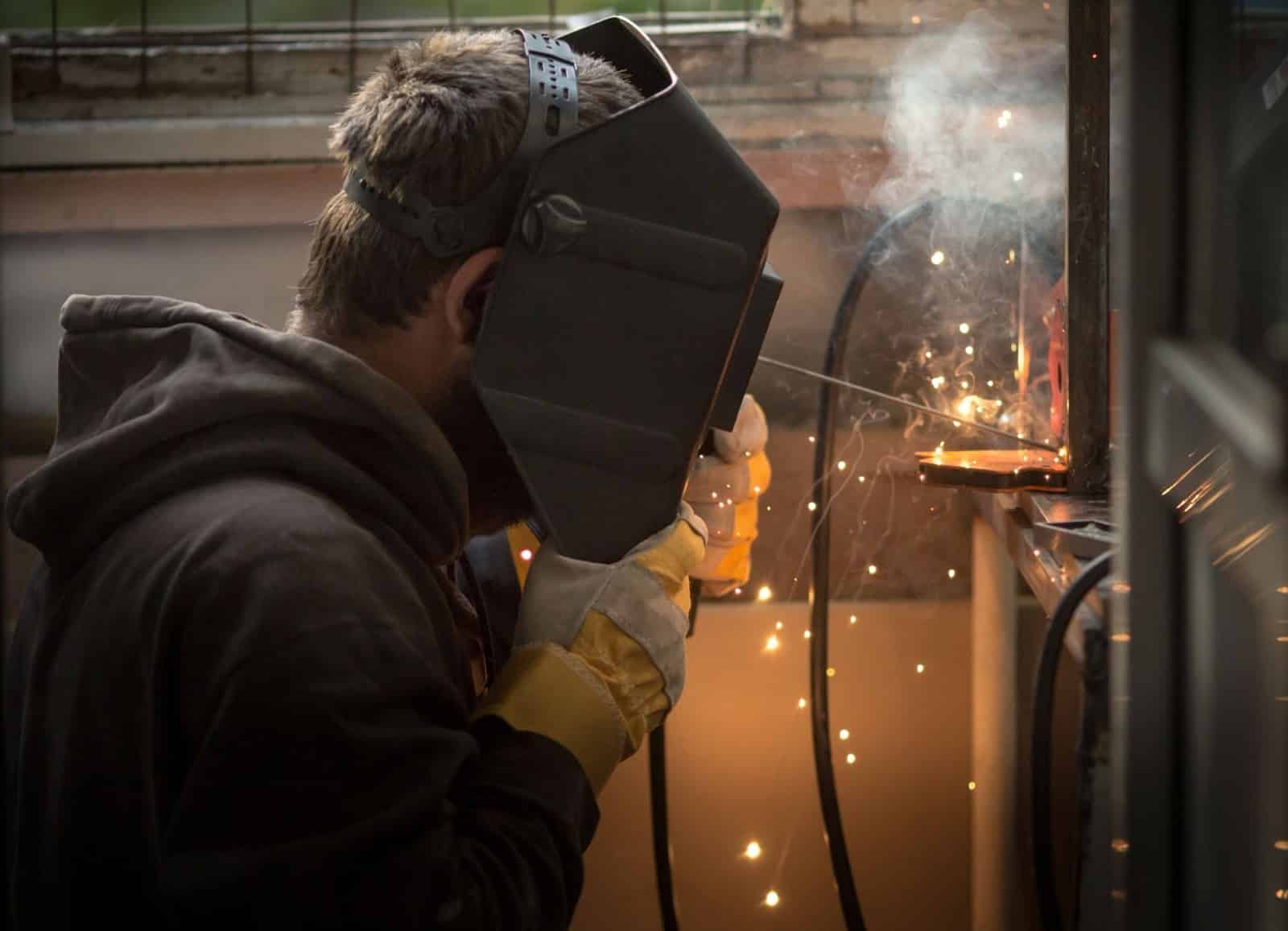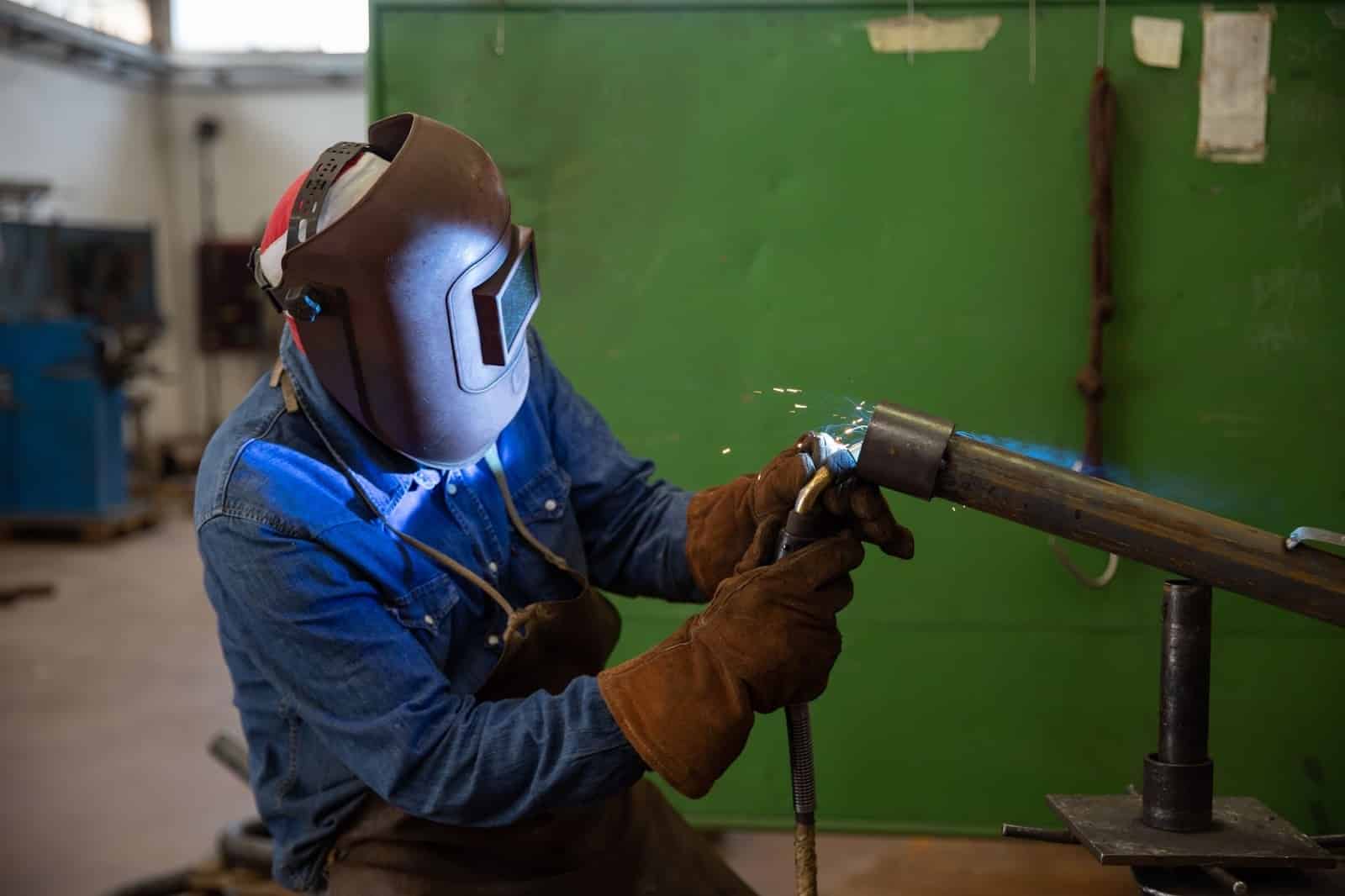If you’ve tried to weld outside on a windy day or didn’t feel like dragging a huge gas bottle around, gasless MIG welding can make your life a lot easier.
It’s simple, portable, and strong enough for real outdoor work.
In this guide, we’ll walk you through how it works, the wire you need, the right machine settings, and the techniques that help you get clean, reliable welds.
What Is Gasless MIG Welding?

Gasless MIG welding is a welding process that uses flux-cored wire instead of solid MIG wire.
The wire contains a flux material inside its hollow core. When melted by the arc, the flux:
- Produces shielding gases
- Forms a protective slag layer
- Helps stabilize the arc
- Enhances penetration in thicker materials
This internal flux eliminates the need for an external gas tank, making the process portable, forgiving, and ideal for situations where wind would blow shielding gas away.
Technically, it is a type of FCAW-S (Flux-Cored Arc Welding – Self-Shielded).
How Gasless MIG Welding Works?

Gasless MIG works by feeding a self-shielded flux-cored wire through your MIG gun.
Here’s what happens during the weld:
- The flux-cored wire feeds through the MIG gun.
- The wire contacts the workpiece and forms an arc.
- The flux inside the wire melts and produces protective gases.
- A slag layer forms on top of the weld bead, shielding it as it cools.
- The molten metal solidifies into a strong weld.
Because the gas is created inside the wire, it can’t be blown away by wind, making it perfect for outdoor repairs, farm work, and field welding.
What Jobs Are Best for Gasless MIG Welding?
Gasless MIG works best for outdoor and heavy-duty jobs where portability and penetration matter.
Gasless MIG is best for:
- Outdoor repairs
- Rusty or dirty steel
- Thick steel plates (¼ inch and above)
- Farm equipment and fences
- Heavy machinery repairs
- Structural steel
- Car frames and chassis
- Construction sites
While it may not produce the cleanest welds for thin sheet metal, it excels in strength, penetration, and portability.
What Wire Do You Use for Gasless MIG Welding?
You must use self-shielded flux-cored wire, usually labeled:
- E71T-GS
- E71T-11
These wires come in several diameters:
- 0.030″ – great for most 110V welders
- 0.035″ – better penetration for 220V welders
- 0.045″ – industrial work
Wire Selection Guide
- E71T-GS: Best for thin materials and single-pass welds.
- E71T-11: Suitable for multi-pass welding and thicker materials.
Important:
Solid MIG wire (ER70S-6) cannot be used without external gas.
What Are the Benefits of Gasless MIG Welding?

Gasless MIG offers several advantages, especially when you’re working outdoors or on rough steel.
1. Works Perfectly Outdoors
Gasless MIG is unaffected by:
- Wind
- Light rain
- Drafty barns
- Open job sites
Unlike solid wire MIG, there is no gas to be blown away.
2. Strong Penetration on Thick Steel
Flux-cored wire burns hotter than solid wire, allowing deeper penetration into steel, ideal for thicker materials and structural repairs.
3. No Need for Gas Cylinders
Eliminates:
- Renting or buying gas tanks
- Transporting heavy cylinders
- Gas regulators and hoses
This makes gasless MIG highly mobile and cost-effective.
4. Great for Dirty or Rusty Steel
Handles Dirty, Painted, or Rusty Metal Better
Flux contains deoxidizers that help burn through:
- Mill scale
- Light rust
- Old paint
- Dirt
If you’ve ever welded an old trailer, you know how helpful this is.
5. Higher Deposition Rates
Gasless MIG lays down more metal in less time than MIG with solid wire, increasing productivity.
What Are the Drawbacks of Gasless MIG Welding?
Like every process, gasless MIG has limitations.
1. More Spatter
Flux-cored welding produces more:
- Spatter
- Smoke
- Fumes
Cleanup is often required.
2. Slag Removal Needed
A slag layer forms on top of the weld and must be chipped or brushed off, especially before additional passes.
3. Not Ideal for Thin Sheet Metal
Metal thinner than 18 gauge (1.2 mm) is easy to burn through.
For automotive body panels, shielding gas MIG or TIG is better.
4. Weld Appearance Is Rougher
Gasless MIG welds are strong but not always aesthetically perfect.
How Should You Set Up a Gasless MIG Welder?
Correct setup is critical for clean, strong welds.
1. Switch Polarity
Gasless MIG uses DCEN (Direct Current Electrode Negative).
Set your machine to:
- Gun = Negative (-)
- Ground Clip = Positive (+)
If polarity is reversed, expect:
- Excess spatter
- Poor penetration
- Unstable arc
2. Choose the Right Wire Size
- 0.030″ – best for most light-duty welders
- 0.035″ – for thicker materials
- 0.045″ – industrial-grade work
3. Stick-Out Distance
Gasless MIG requires a slightly longer stick-out than gas MIG:
- ½ inch to ¾ inch
This keeps the flux burning properly.
4. Drag Technique
Always drag/pull the weld when using flux-cored wire.
This allows the slag to stay behind the puddle.
Avoid pushing, it causes:
- Porosity
- Weak penetration
- Poor bead shape
How Do You Weld With a Gasless MIG Welder? (Step-by-Step)
Step 1: Clean the Metal
Remove heavy rust, grease, loose paint, or mud. Light mill scale is fine.
Step 2: Set Polarity and Wire Speed
Double-check polarity before welding.Adjust wire feed until you hear a stable crackling sound.
Step 3: Position Your Ground Clamp
Clamp it on clean, bare metal near the weld.
Step 4: Start with Short Welds
Practice by welding short beads to dial in your settings.
Step 5: Use the Drag Angle
Maintain a 10–15° drag angle.
Step 6: Maintain Consistent Travel Speed
Move too fast → weak weld
Move too slow → excessive slag and burn-through
Step 7: Remove Slag Between Passes
Use a chipping hammer or a wire brush.
Common Problems and How to Fix Them
1. Excessive Spatter
Reasons:
- Wrong polarity
- Too much voltage
- Dirty metal
Fix:
Adjust settings and clean the surface.
2. Porosity
Reasons:
- Moist wire
- Draft or wind blowing into weld area
- Incorrect travel angle
Fix:
Store the wire properly and drag the weld.
3. Burn-Through
Reasons:
- Too much heat
- Thin material
Fix:
Lower voltage or switch to gas MIG.
4. Weak Penetration
Reasons:
- Too fast travel speed
- Low voltage
Fix:
Slow down and increase heat.
(Most beginners move too fast. Slow down and the bead quality usually improves immediately.)
Safety Tips for Gasless MIG Welding
- Use a welding helmet with proper shade.
- Wear fire-resistant gloves and jacket.
- Ensure good ventilation, flux fumes are strong.
- Keep your workspace dry.
- Store wire properly to avoid moisture absorption.
Conclusion: Is Gasless MIG Welding Worth It?
Gasless MIG is one of the easiest ways to weld outside, fix heavy steel, and handle repairs when you don’t have a gas cylinder nearby.
You’ve now seen how to choose the right wire, set up your machine, and use the drag technique to get cleaner, stronger welds.
While it doesn’t produce the cleanest welds compared to gas MIG or TIG, its ability to work in real-world conditions, especially outdoors, makes it a reliable choice for structural welding, heavy-duty repairs, and everyday fabrication.
Mastering gasless MIG welding means understanding your machine, using the right wire, maintaining proper polarity, and practicing good form. When done correctly, it produces durable welds that withstand harsh environments and tough materials.
FAQs About Gasless MIG Welding
Yes, gasless MIG welding is great for outdoor repairs, thick steel, and situations where you don’t want to deal with gas cylinders.
It runs hot, offers strong penetration, and handles dirty steel better than solid-wire MIG.
Gasless welds are very strong, especially on medium and thick steel. Flux-cored wire burns hotter than solid wire, which helps the weld fuse deeply into the joint.
You can reduce spatter by checking polarity (DCEN), cleaning your metal, lowering voltage slightly, and keeping a steady travel speed.
A longer stick-out—around ½” to ¾”—also helps the flux burn more consistently, which cuts down on spatter.
Gasless MIG is easier to learn and leaves a cleaner bead than stick.
It also produces less slag and usually runs faster.
Stick is tougher in extreme conditions and works on very thick steel, but for most outdoor repairs, gasless MIG feels smoother and more beginner-friendly.
You can, but it’s not recommended.
Gasless MIG runs hot and tends to burn through thin automotive sheet metal. For car bodies, use MIG with gas (solid wire ER70S-6) or TIG.
Gasless MIG is better suited for frames, brackets, and thicker automotive parts.



